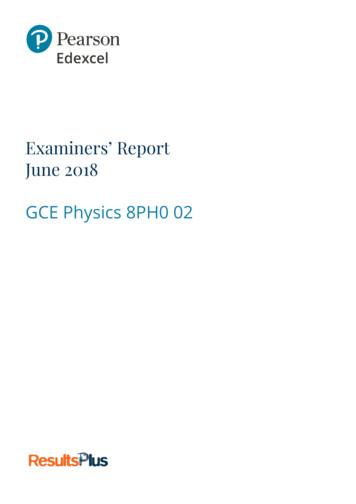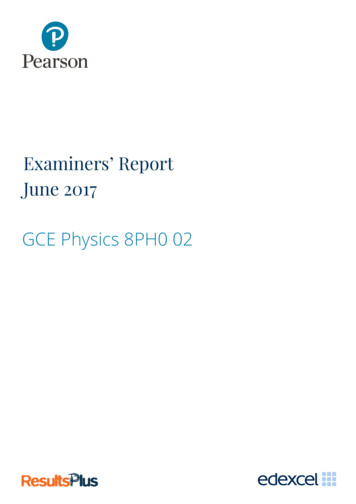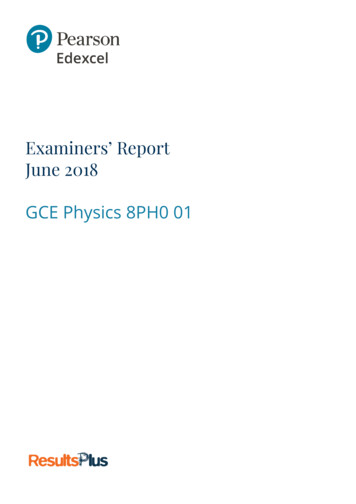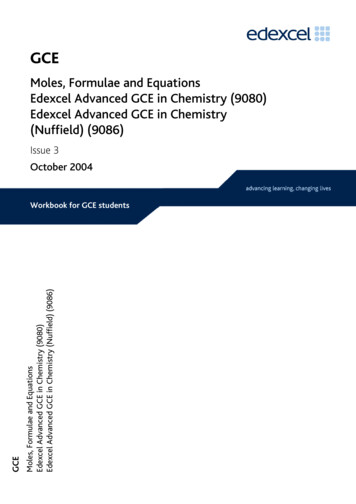
Transcription
Examiners’ ReportJune 2018GCE Physics 8PH0 02
Edexcel and BTEC QualificationsEdexcel and BTEC qualifications come from Pearson, the UK’s largest awarding body. We provide awide range of qualifications including academic, vocational, occupational and specific programmesfor employers. For further information visit our qualifications websites at www.edexcel.com orwww.btec.co.uk.Alternatively, you can get in touch with us using the details on our contact us page atwww.edexcel.com/contactus.Giving you insight to inform next stepsResultsPlus is Pearson’s free online service giving instant and detailed analysis of your students’exam results.See students’ scores for every exam question.Understand how your students’ performance compares with class and national averages.Identify potential topics, skills and types of question where students may need to develop theirlearning further.For more information on ResultsPlus, or to log in, visit www.edexcel.com/resultsplus.Your exams officer will be able to set up your ResultsPlus account in minutes via Edexcel Online.Pearson: helping people progress, everywherePearson aspires to be the world’s leading learning company. Our aim is to help everyone progressin their lives through education. We believe in every kind of learning, for all kinds of people,wherever they are in the world. We’ve been involved in education for over 150 years, and byworking across 70 countries, in 100 languages, we have built an international reputation for ourcommitment to high standards and raising achievement through innovation in education. Find outmore about how we can help you and your students at: www.pearson.com/uk.June 2018Publications Code 8PH0 02 1806 ERAll the material in this publication is copyright Pearson Education Ltd 20182GCE Physics 8PH0 02
IntroductionThis is the third time that the Pearson Edexcel AS paper 8PH0 02, Core Physics II, has been sat bystudents. Section A of the paper contains eight multiple choice questions followed by questions ofincreasing length and increasing demand. This section examines the Waves and Materialscomponents of the course providing a transition for students between GCSE and A Level. Section Bcontains two questions, with the first question taking inspiration from a short passage. This sectionis designed to provide a synoptic element with responses from any part of the AS specificationexpected. In this case Question 15 relied on knowledge from some aspects of dc electricity andmechanics, whilst Question 16 required understanding of fluid mechanics. This paper enabledstudents of all abilities to apply their knowledge to a variety of styles of examination questions.Many students have shown good progression from GCSE to AS level, with prior knowledgeextended. Some questions were not answered as well by many students as would have beenexpected . Full written and open response questions, in particular, fell into this category as studentsstruggled to explain the physics, as in Q9. students would benefit from more practice at applyingfamiliar ideas and concepts in an unfamiliar context in order to follow through an argument andreach a conclusion, as in Q14(b)(iii). The recall of some basic mathematical equations such as thevolume of a sphere was not known to some.Analysis of Multi-choice questionsMultiple-choice questions were generally well answered. The more able student typically scored atleast 7 correctly whilst an E grade student typically scored around 5 marks.QuestiondescriptionPercentage ofstudents withcorrect responseCommon incorrectresponses1Expression for Young Modulus87%D2Pulse Echo84%A3Stationary waves56%A,C4Photoelectric equation78%B5Diffraction of electrons60%C,D6Phase difference54%B,D7Speed of a wave on a string59%C,D8Mass per unit length of a string70%AGCE Physics 8PH0 023
Question 9This 6-mark indicative content question proved a challenge to many. Whist it was clear that thistype of the hysteresis graph was familiar to many, students struggled to describe its shape in acoherent manner. Those who were the most successful at this question started with observationsfrom the graph (as the question suggested) and then used their knowledge of force-extensiongraphs to explain these observations in terms of forces and in terms of energy.Firstly recognising that this is not a straight line graph and, secondly, that the start and end pointsare the same, leads to MP1 and MP2. These were the most commonly scored marks. MP3 wasawarded for a comparison between the shape of the two graphs with an explanation of thedifferences when loading and unloading in terms of force and extension. MP4 was awarded for acomparison in the area under the graphs for loading and unloading, with an explanantion in termsof energy, for MP5. Finally, MP6 uses all of this to explain the hysteresis in terms of the transfer ofheat energy, linking back to information given in the question.4GCE Physics 8PH0 02
GCE Physics 8PH0 025
This answer scores 5 indicative marking points.MP1 in line 2. Allowance was made for the graphbeing approximately a straight line for small forcesand extensions.MP2 last sentence.MP3 not awarded.MP4 in lines 3 to 4.MP5 in lines 4 and 5.MP6 in lines 6 to 8. "energy lost" on its own isinsufficient, but in this answer it links back tothermal energy in line 4.The marks awarded for these 5 incative markingpoints plus the linkage marks gave a total of 5 forthe question.6GCE Physics 8PH0 02
Question 10 (a)A 2-mark calculation using the equation from the back of the examination paper for elastic strainenergy.A correct answer showing all working clearly.A common incorrect answer.This student has used the equation for work done force X distance not realising that the work doneon the spring is equal to the elastic strain energy.GCE Physics 8PH0 027
Question 10 (b)A 2-mark calculation using the Hooke's law equation as given at the back of the examination paper.Students were expected to realise that, as the same spring is used, the spring constant remains thesame in both (a) and (b).This student has used data from the question tocalculate a value for the spring constant of thespring, k. This is then substituted back into theHooke's law equation using the new data to arriveat a correct answer.8GCE Physics 8PH0 02
This student has bypassed the need to determinea value for the spring constant by equating theratios of extension to force for the two situations.Rearranging the equation they then reach a correctvalue for the extension.Be careful with units. Usually it is wise to convertcm to m. However in this question it was notnecessary to do this as long as the correct unit forextension was given at the end.When calculating the force, extension should be inSI units.GCE Physics 8PH0 029
Question 11 (a)A question assessing the student's ability to judge factors that might affect the accuracy ofmeasurements.Many students indicated the need for repeats and this was one of the more common responsesseen. However, they could not score the mark if they then failed to state that a mean should bedetermined.There were many responses referring to using thin /sharp pencils which did not score a mark. Alsoparallax, which did not score a mark as the protractor would have been flat on the paper and soparallax would not have been an issue.This student scores 2 marks - for the use of largeangles (one mark) and thin rays (second mark).Neither of these were commonly seen.Accuracy is an indication of how close ameasurement is to the true value10GCE Physics 8PH0 02
Question 11 (b)(b)(i) Correct use of the term resolution means thatthis student could access full marks. A correctconclusion is given to the suggestion of aresolution of 1 degree.(b)(ii) An attempt at a percentage uncertaintycalculation using an uncertainty of 0.5 has beenmade. Unfortunately they have used an angle of 50degrees ( i) instead of the correct 29 degrees,(angle r when i 50 degrees). This mistake was notuncommon.GCE Physics 8PH0 0211
Students would benefit from revising the glossaryin appendix 10 of the specification. Use of thesekey terms can help to raise the level of a students'written responses.A correct answer scoring full marks.12GCE Physics 8PH0 02
Question 11 (c)In part (c)(i) the line of best fit proved a challenge for many students. The line was judged by aneven spread of points lying either side of the line. The final point at sinr 0.6 could have beentreated as an anomaly and ignored.GCE Physics 8PH0 0213
14GCE Physics 8PH0 02
(i) An acceptable line of best fit for this student.They have not treated the final point as ananomaly and have an even spread of points eitherside of the line.(ii) A gradient has been calculated, using a largerange for sini and sinr shown clearly with thedrawing of the triangle on the graph. Refractiveindex is calculated correctly with a correctconclusion.Some students used the data points from the stemof the question instead of calculating a gradient sowould have been unable to score MP1.When calculating gradients use as large a range ofthe x and y axes as possible but it must be at leasthalf the height or width of the graph. It is goodpractise, and makes it clear to the examiner if thetriangle is drawn on the graph. This can also avoiderrors with calculating the change in x and thechange in y, especially when (as is the situationhere) the line does not go through the origin.GCE Physics 8PH0 0215
16GCE Physics 8PH0 02
The line of best fit is sufficient for the mark. Thefinal point has been treated as an anomaly andignored. There are three points on the line and twoother points sitting equidistant either side of theline, constituting an even spread of points. The linehas not been forced through the origin.When drawing lines of best fit, do not force the linethrough the origin.GCE Physics 8PH0 0217
Question 12 (a)Students demonstrated an understanding of energy levels This has been a common theme in pastpapers, but in the context of energy gained from the absorption of photons. The context in thisquestion, with energy gained from collisions, was clearly less familiar and this caused somedifficulties. Some students confused this with the photoelectric effect with photons absorbed andphotoelectrons emitted. Marks could not be awarded for repeating information from the question.18GCE Physics 8PH0 02
MP1 awarded in line 1 despite the misspelling ofdiscrete. However, "electrons exist in certainenergy levels" would not have been accepted as itdoes not convey the same meaning.MP2 lines 4 and 5.MP3 line 6.MP4 and MP5 in the last 4 lines.This response, of over 10 lines, contains only onesentence, making it more difficult to read.GCE Physics 8PH0 0219
MP1 in line 5. Since the student is referring toelectrons rather than atoms.MP2 line 2 the idea that an electron moves downan energy level.MP3 line 3.MP4 lines 4 and 5 linking energy changes tofrequency.MP5 lines 4 to 6.Marks are not awarded for repeating informationin the question. Use the information given but addfurther detail.20GCE Physics 8PH0 02
Question 12 (b)When the electron collides with the mercury atom its speed, and hence its kinetic energy, decreasesas it tranfers energy to the atom during the collision. The amount of energy transferred is equal tothe difference in the kinetic energy of the electron before and after the collision. The wavelengthemitted by the mercury atom corresponds to the total energy absorbed by the mercury atom.As this is a "deduce" question, having calculated a value for wavelength, candidates are expected touse the data in the table to state which type of radiation is emitted.GCE Physics 8PH0 0221
This is a correct 4 mark answer.In the first 5 lines the student has correctlycalculated the kinetic energy of the electron ateach of the two speeds and then subtracted theiranswers to calculate the change in energy of theelectron due to the collision.They have then correctly calculated the frequencey(lines 6 and 7) and the corresponding wavelength(last line) to obtain an answer within theaccepetable range (2.37 rounds to 2.4). For thefinal mark a conclusion of ultraviolet is given.22GCE Physics 8PH0 02
In this response the difference in the two speedshas first been determined and then this valuesubstituted into the formula for kinetic energy.This is incorrect as the value obtained is not thechange in the kinetic energy of electron. Thismistake was often seen.However they have scored MP2 and MP4. Whilsttheir final numerical answer is incorrect, and sonot achieving MP3, they have made a correctconclusion (infrared) based upon their answer andso can score MP4.GCE Physics 8PH0 0223
Question 13 (a)A wavefront is a line or surface along which all the points on a wave are in phase. (This enables ameasurement of wavelength to be made from the distance between wavefronts).Many students were unsure on this. They had the idea but were unable to express it concisely.This answer gains the mark. The student did notneed to write both line and surface for the mark.Students should memorise this.24GCE Physics 8PH0 02
Question 13 (b) (i)Any idea that a laser should not be shone towards the eye.Unqualified reference to the wearing of goggles was commonly seen but was not accepted.Scores 1 mark.GCE Physics 8PH0 0225
Question 13 (b) (ii)This question required the idea of evidence, or lack of.Students would benefit from gaining an appreciation of the history of the development of the waveparticle duality concept.This scores the mark for the last alternative on themarkscheme "support for the particle model" asthey have stated that the support came from aneminent scientist.A significant number of students referred toEinstain or the photoelectric effect, neither ofwhich were around in 1803.26GCE Physics 8PH0 02
An example of a response that scores for the firstalternative "lack of evidence".GCE Physics 8PH0 0227
Question 13 (c) (i)Part (c) is assessing the student's knowledge of a core practical. The explanation of interferencepatterns is well visited but this question considers only one part of the interference pattern whenthe two slits are equidistant from the screen.To explain the existence of a bright line requires three points to be made about each of: the pathdifference, the phase difference and whether this is constructive or destructive interference.In this case as the slits are equidistant from point 0 (as stated in the question), there is zero pathdifference. Consideration of the path difference was often missing. Some students mentioned pathdifference as a whole number of wavelengths which did not allow them to score the mark, as thiswas not specific enough.The waves are in phase at this point which gives constructive interference and hence a bright line.MP2 and MP3 were more commonly seen.This response scores 3 marks.Superposition is accepted in place of interference,but not superimposition.28GCE Physics 8PH0 02
A correct 3-mark answer.MP1 line 1. This mark was least commonlyawarded as students did not mention pathdifference.MP2 line 2MP3 line 3Question 13 (c) (ii)Drawing on knowledge that the path difference between the two waves is one whole wavelengththe only acceptable answer is 600 nm.GCE Physics 8PH0 0229
Question 14 (a) (iii)This is a real image as it is formed on the other side of the lens to the object.Most students realised that this was a real image. An explanation alluding to the rays passingthrough the image was a common response although some found it difficult to express with clarity.A perfect answer.A common response was to state that "the imagewas formed on the other side of the lens". Thisdoes not make it clear that object and the imageare on different sides of the lens.30GCE Physics 8PH0 02
Question 14 (a) (i) - (ii)It was encouraging to see that students generally used a ruler and sharp pencil to complete the raydiagram. Those students who were unable to recall how to draw the paths of the rays were unlikelyto score well in the whole of this question totalling 5 marks.Some students did not realise where the rays changed direction and drew rays that seemed tochange direction in random places.Care needs to be taken in drawing the rays, using both a ruler and the lines on the graph paper as aguide. A small inaccuracy on the left hand side of the diagram could lead to a larger inaccuracy inlocating the position of the image on the right hand side.GCE Physics 8PH0 0231
This response shows the paths of two rayscorrectly drawn using a ruler with the image drawnin the correct position. Three marks is scored inpart (a)(i).In (a)(ii) the magnification is correctly calculatedusing the ratio of the height of image to height ofobject. Alternately a ratio of image distance toobject distance could be calculated.Whilst the position of the image can be located bydrawing just two rays, it is good practice to add thethird ray because if the three rays do not all meetin the same place, this can highlight when the pathof one ray has been incorrectly drawn.32GCE Physics 8PH0 02
Question 14 (b) (i)The requirement in this question was for the description of a method. Therefore the emphasisshould be on measurements that need to be made. The focal length is the distance between thelens and the position of the image formed from an object at infinity or (approximately) an object ata large distant from the lens.The image of a distant object can be projected on to a screen and the distance between the screenand the image is measured. Alternatively, using parallel rays from a ray box, since rays from acommon point at infinity will be parallel when they are incident on the lens. The focal length is thedistance between the lens and the point at which the rays converge.Correct description using parallel rays and acorrect measurement for the focal length has beenstated.The focal length is the distance from lens to image.GCE Physics 8PH0 0233
Question 14 (b) (ii)Rays of light are refracted on passing through a lens. The thicker lens will cause more refractionand a shorter focal length as the rays of light converge at a point closer to the lens.For MP1 correct reference to refraction was required. References to reflection or diffraction werealso seen and scored no mark.For MP2 rays converge or meet at a point closer to the lens. It is incorrect here to state that the raysmeet at the focal point. This is only true if the rays arriving at the lens are parallel.Correct reference to refraction for MP1. For MP2the rays are meeting at a point closer to the lens.34GCE Physics 8PH0 02
Question 14 (b) (iii)Students found this question challenging. The unfamiliar context required students to use theirknowledge of the magnification of a lens (m v/u) as a starting point and use this to follow through alogical argument to arrive at a conclusion.Students answering this question most successfully started with the equation m v/u . Firstly,making the observation that photograph 2 is more magnified. Secondly, although this was notcommonly stated, establishing that u is the same in both photographs. Then it can be seen fromthe equation that v must be larger. This then leads to a larger f from the thin lens formula arrivingat the 200 mm lens. This seemed counter intuitive to many. A significant number deduced that oneor either of the two lenses was more powerful and so produced a more magnified image. Thesestudents were not distinguishing between situations involving near and far objects and wereprobably thinking about the image produced by a magnifying glass.GCE Physics 8PH0 0235
A 5- mark answer. This student has stated releventequations and starting with a high magnificationhas used the equations to follow through anargument, leading to the correct conclusion.MP1 lines 2 and 3.MP2 lines 4 and 5.MP3 line 4.MP4 line 5.MP5 correct conclusion in last 2 lines.36GCE Physics 8PH0 02
Another 5-mark answer. In this response thatstudent has followed the argument in the reverseorder starting with the assumption that the focallength increases and using the thin lens formula.MP1 line 6.MP2 line 5.MP3 line 3MP4 line 2.MP5 last 2 lines.GCE Physics 8PH0 0237
This response scores 3 marks all in the first 3 lines.The second half of the response is repeating whathas already been said but for the alternative lens.The term "zooming in" was frequently seen. Whilsta common photographic term, this is not a physicsterm and so needed clarifying for MP1.38GCE Physics 8PH0 02
Question 15 (a)In high intensity light the rate of incident photons is greater. Since one photon is absorbed by oneelectron, more electrons are released every second. A greater rate of electrons pass through theexternal circuit creating a larger current and the batteries charge more quickly.Some key ideas of physics were being assessed in this question.a higher intensity of light means the rate of incident photons is greaterone photon is absorbed by one electronlinking an increase in the rate of electrons with an increase in currentGCE Physics 8PH0 0239
40GCE Physics 8PH0 02
A good 4-mark answer.Line 1: more photons per second for MP1.Line 2: the idea of a one to one interactionbetween photons and electrons for MP2.Line 5: "more photoelectrons" also linked to anincreased rate from line 1 for MP3.Line 6: more current.GCE Physics 8PH0 0241
MP1 and MP3 could not be awarded unless there was a clear reference to rate or number per unittime. MP4 needed to refer to a quantity in the external circuit that was greater as a result.Many students incorrectly referred to an increase in the energy of photons in high intensity light,transferring a greater energy to the electrons, leading to an increased current.Scores 4 marks.MP1 lines 2 and 3MP2 line 3MP3 line 4MP4 lines 5 and 6A high intensity of light means that there are morephotons per second.A large current means the rate of flow of electronsis greater.42GCE Physics 8PH0 02
Question 15 (b)To determine the energy generated the power must first be determined using P I x A. The powercan then be substituted into E P x t ensuring that the time (8 hours) is converted into seconds.Use of the two relevent equations for intensity and power were often well done. Many students didnot multiply the energy by an efficiency of 23% limiting their score to two marks. This information iswithin the passage (5th line).MP1 top two lines of working, for using P I x A,arriving at P 26000 WMP2 third line of working, for using E P x t withtime converted to seconds, arriving at E 7488 MJMP3 last line of working, multiplying by efficiencyof 23% to give correct final answer.GCE Physics 8PH0 0243
Highlight key points made in the passage to helpyou remember that they are there as you answerthe questions.44GCE Physics 8PH0 02
Question 15 (c)Using E P x t with information given in the passage. There are four motors each with a power of7.5 kW.A correct 2-mark answer. The answer may be givenin any correct unit MJ, kJ, J.Don't forget to convert kW to W, and time fromhours to seconds.GCE Physics 8PH0 0245
Question 15 (d)Using change in gravitation potential energy mass x g x change in height with information given inthe passage.A correct answer.46GCE Physics 8PH0 02
Question 15 (e)There needs to be an appreciation that, at night, the motors need to use as small amount as energyas possible.Air resistance is greater at faster speeds or, at lower heights where the air is more dense. Withmore air resistance the motors would need to provide a greater forward force and thereforerequire more energy. The plane flies at a lower speed at this lower height to conserve batteryenergy.A good 3-mark answer.GCE Physics 8PH0 0247
This is a well written answer scoring 2 marks. Thisanswer scores MP1 and MP3 but has not referredto force from the motors to gain MP2.48GCE Physics 8PH0 02
Question 15 (f)Many students referred to the idea that solarplanes would provide a "greener" or "moreenvironmentally friendly" method of flying. Use ofthese terms do not generally gain credit as theyare vague terms showing little progress fromGCSE. The emphasis for this question is on theadvancement of the technology, not necessarilylinked solely to air travel.In this response the mark is secured in the first fivewords, as it conveys the advancement oftechnology.GCE Physics 8PH0 0249
Scores one mark for the idea of advancing solartechnologies.A good one mark answer.50GCE Physics 8PH0 02
Question 16 (a)Using the information in the question it should be established that the resultant force F is equal to0 as the balloon has reached a constant upwards speed and the vertical forces are balanced.With F 0, to calculate the viscous drag force, the upthrust and weight need to be determined.weight (mass of balloon helium) x gupthrust (density of air) x volume of balloon x gThe weight was commonly calculated correctly. Of those students who remembered how tocalculate upthrust, a common mistake was the recall of the volume of sphere, with the equation forthe area of a circle often seen.GCE Physics 8PH0 0251
A 4-mark answer.Line 1: the student has written out the expressionfor upthust with F 0 scoring MP1.Line 2: the student has shown working for each ofthe terms upthrust and weight. In this case it canbe assumed that the F corresponds to viscous dragfrom their expression on the first line.Line 3 and 4: substitution of correct values leadingto a correct answer.52GCE Physics 8PH0 02
This student has carried out the correct methodbut has used an incorrect formula for the volumeof a sphere (on line 2) so cannot score MP3 andMP4. This was a common mistake.Learn the formula for the volume of a sphere.GCE Physics 8PH0 0253
This answer shows another common mistake. Onthe second line they have attempted to calculatethe upthrust but have omitted g.54GCE Physics 8PH0 02
Question 16 (b)There needed to be a link between viscosity and temperature. On a warmer day viscosity increasescreating a larger force opposing the motion of the balloon.Scores one mark on the first line.GCE Physics 8PH0 0255
Paper SummaryThis paper provided candidates a wide scope in which to demonstrate their understanding of thephysics within the AS specification. Questions included both short and long written responses,aswell as short and multi-step calculations.Based upon the performance on this paper, students would benefit from:memorising key mathematical formulae that are not provided on the paper, such as the volumeof a spherememorising definitions, for example in this paper, the definition of a real image and of awavefront.learning to recognise and apply the relevent physics in unfamiliar situationsfurther practise at writing a coherent argument to form a logical conclusionpractise at evaluating practical investigations and calculations of uncertaintiespractise at drawing a line of best fit on a graph of real data to give an even spread of points eitherside of the line.56GCE Physics 8PH0 02
Grade BoundariesGrade boundaries for this, and all other papers, can be found on the website on this undaries.aspxGCE Physics 8PH0 0257
Pearson Education Limited. Registered company number 872828with its registered office at 80 Strand, London WC2R 0RL.Powered by TCPDF (www.tcpdf.org)
2 GCE Physics 8PH0 02. Introduction This is the third time that the Pearson Edexcel AS paper 8PH0 02, Core Physics II, has been sat by students. Section A of the paper contains eight multiple choice questions followed by questions of increasing length and increasing demand. This section examines the Waves and Materials










